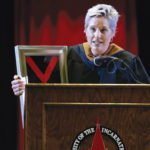The commitment to serve wasn’t limited to those on campus. Alumni of the Department of Meteorology were in a unique position to help assist and inform the public.
Carolina Jones, weather graphics producer and meteorologist for AccuWeather, was at the Pennsylvania-based station at all hours of the day and night before the storm hit. “We knew about a week out that it would make landfall in Texas and it was going to be significant,” she said. “Everyone was saying it was going to be catastrophic. It was going to be really bad, something we had never seen.”
It was personal for Jones, a 2015 graduate, whose friends and family are based in Texas. At work, she created graphics with her team that communicated urgent weather news, including inches of rain anticipated and potential tornado warnings. But, she was also checking in with Houston friends to ensure they had plans in place. “It was surreal,” she said.

Alumnus Mike Saenz
In times of approaching storms, when fear and panic are in danger of setting in, directness and accuracy are paramount. Meteorologists are charged with providing the best, most accurate, up-to-the-minute information and
arming viewers with knowledge so they can make life-saving choices. In a way, they are broadcast’s first responders.
She recalled the lessons from her former broadcast and meteorology professor Alex Garcia, who stressed clarity when communicating complicated scientific information.
“That was important for forecasting for Harvey, we needed to create graphics that were simple and easy to read, so people would know what was happening, and understand right away what they would need to be prepared,” she said.
That’s also a principle that alumnus Mike Saenz, weather producer and bilingual meteorologist for The Weather Channel, utilizes in his work.
“I am the only bilingual meteorologist at The Weather Channel,” said Saenz. “One of the things we have recently done is expand coverage to reach out to the audience in the Spanish-language community.”

These graphics created to inform the community
Some areas don’t have bilingual meteorologists, he said, so providing clear forecasts in times of major weather events, is critical. Saenz, the former chief meteorologist at Telemundo in Oklahoma City, puts viewers’ comprehension and safety at the forefront. Via graphics shared on the air and via social media, his messages are wide spread. He often recalls the lessons of Dr. George Frederick, the UIW adjunct professor who taught him critical news techniques.
While weather science is at the core of what these meteorologists do, UIW’s Mission also serves as a guiding tenet. “I never even realized how much attending UIW has changed my perspective of helping others,” said Jones. “I think the community service we put in to earn our degree is so important because you learn to be selfless and have empathy. I try to always put myself in another person’s shoes and this was the basis in creating a clear message for people preparing for Hurricane Harvey. I thought about what I would want to know if I was in the path.”










I personally know her, she have always care for everyone else safety as much as she cares for her carreer. She wanted have warn my family and so many other people about severe weather.